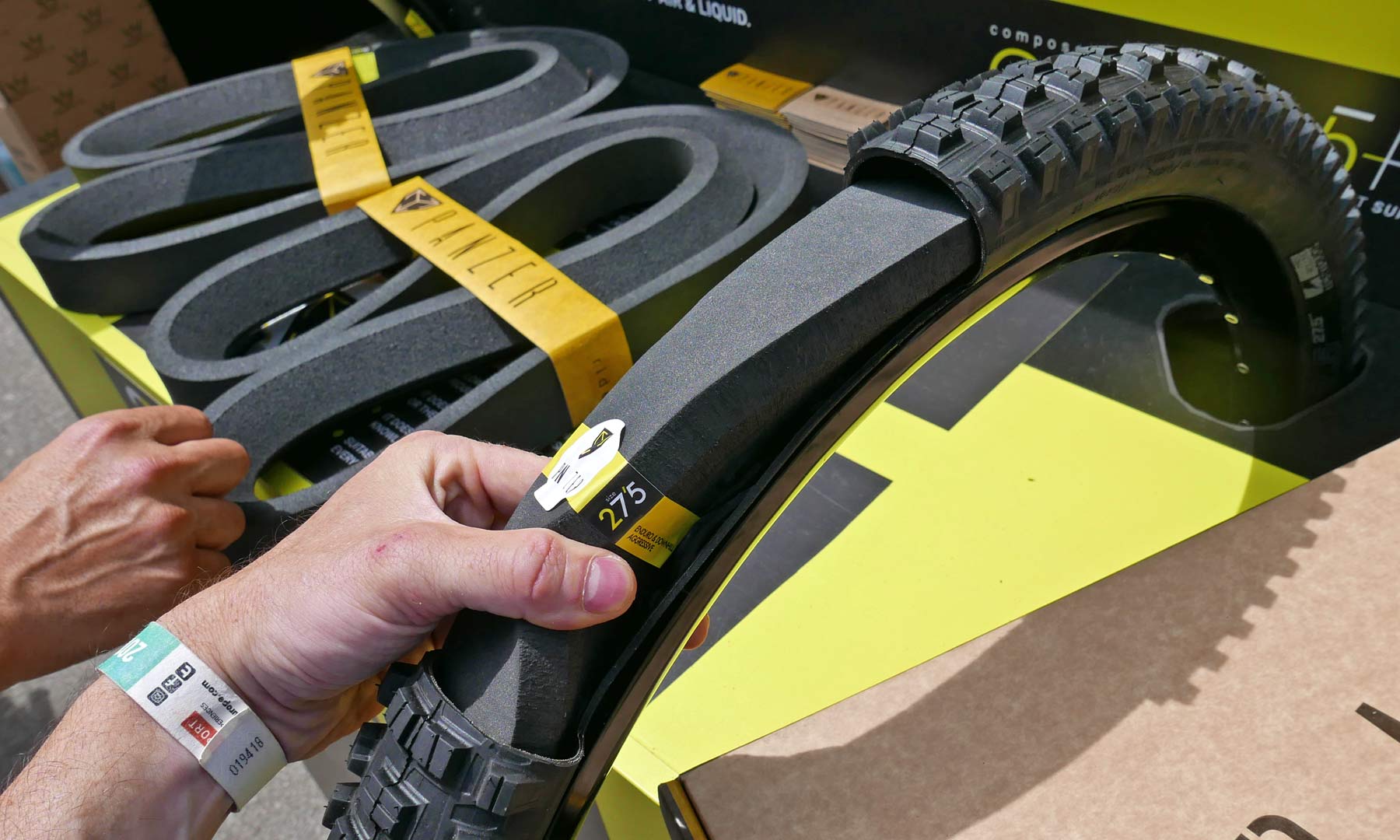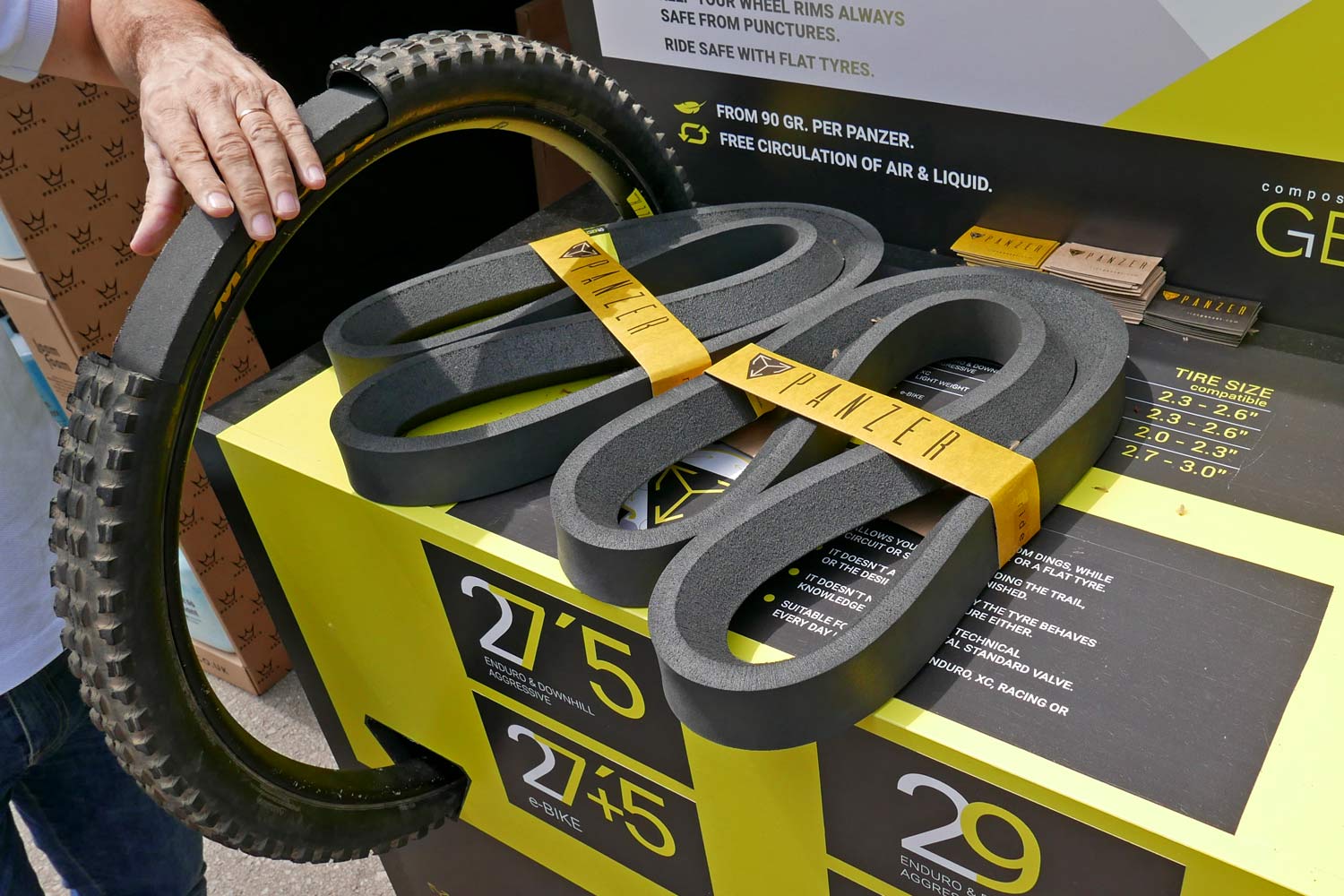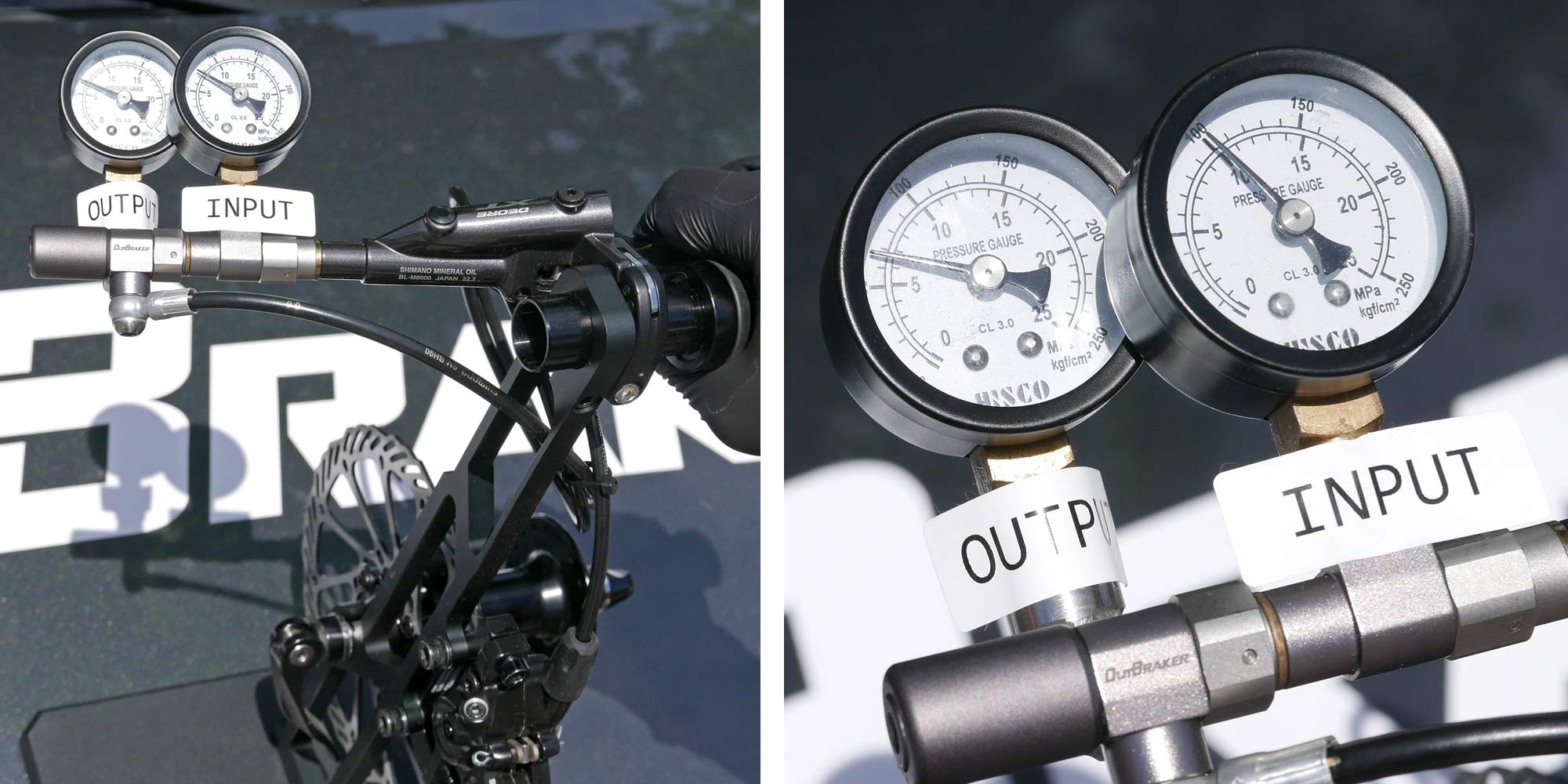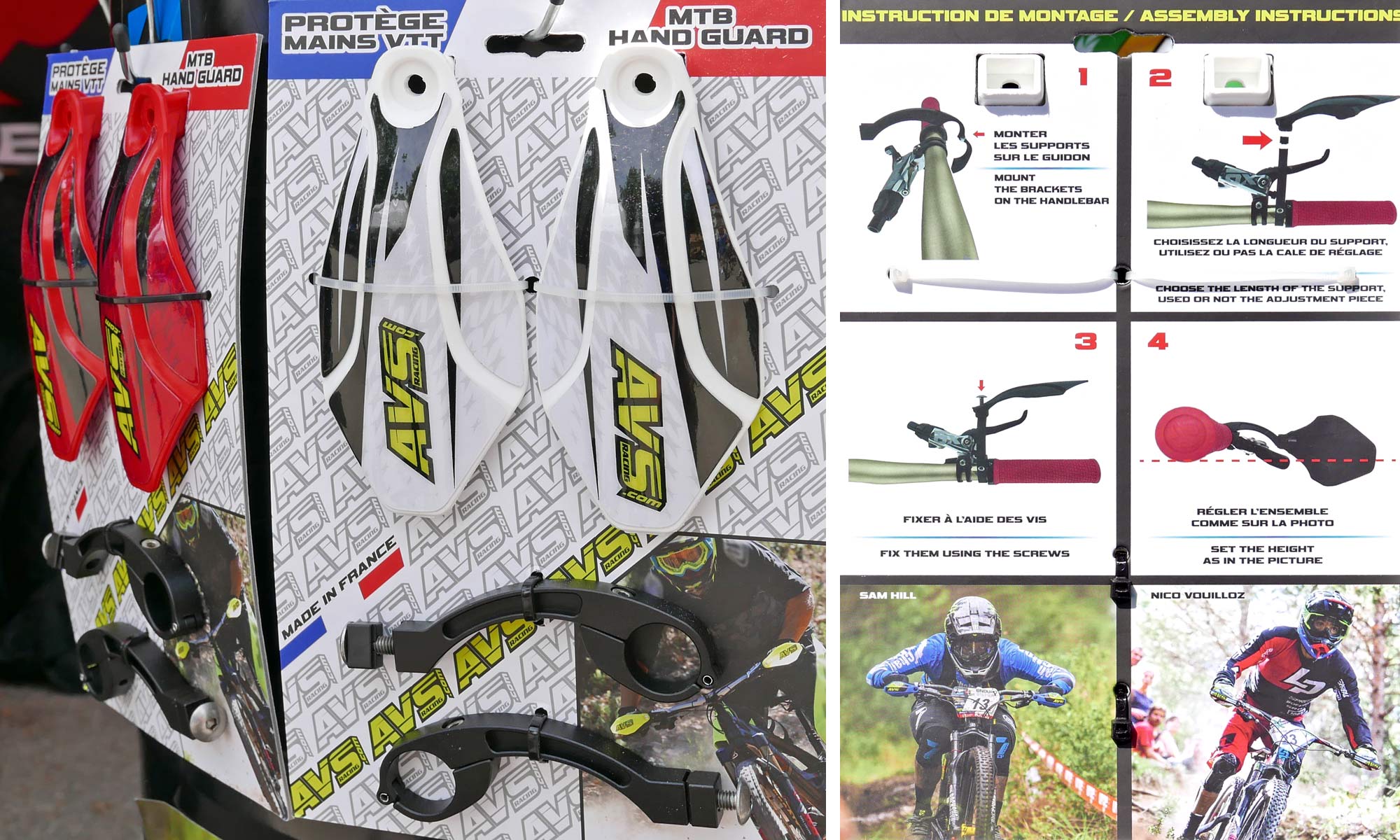Yesterday we looked at some unique bikes that we debuted over the weekend at Sea Otter Girona, and today we have a number of more tech focused items & components. Starting it off Panzer is a new in-tire foam rim protection, paired with Peaty’s eco-friendly tubeless sealant. The anti brake lock Outbraker has a new version developed for Lobito e-bikes, while automated tire pressure regulating White Crow gets some interesting updates. Plus, we get another look at AVS mountain bike hand guards.
Ride Panzer pentagonal foam anti-flat rim protection
We’ve seen a number of different rim inserts designed to prevent flats when running super low pressures in mountain bikes, and to build in the ability to roll out an enduro or DH run if you do flat. The latest I’ve seen is the Panzer, a 5-sided foam ring that freely floats inside the tire cavity letting your tubeless sealant and air inside the tire go where it needs. The Panzer keeps weights low, while letting your tire bend and flex to the ground un affected, and is easy to just pop into your tire easier than a regular tube.
Panzer is available in four different sizes for riding from XC to DH, with a bit of e-MTB in between. The 27.5 aggressive version weighs 100g per tire for 2.3-2.6″ enduro & downhill tires. 29 aggressive weighs 115g again for 2.3-2.6″ gravity tires. 29 light weight is just 70g and suited for 2-2.3″ XC tires. And lastly 27.5+ is designed primarily for e-bikes at 140g per wheel for 2.7-3″ tires.
Panzer rim protectors are currently available for 45€ per wheel for 27.5 aggressive and 49€ per wheel for 27.5+. The 29″ version will be the same price once available.
Peaty’s biodegradable tubeless tire Tubeless Sealant
Peaty’s tubeless tire Tubeless Sealant was specifically formulated to be more eco-friendly. Developed by the former DH World Champ, Peaty’s is an ammonia-free, biodegradable latex-based sealant. The lightweight formula is said to seal quickly with the help of its larger nano-platelet clumps. The sealant also includes corrosion inhibitors that are said to make your alloy rims, and even tires last longer, and promises not to dry out and ball up into boogers inside your tire (or rather tyre).
These 120ml pouches sell for £8, a one liter bottle goes for £30, and a big 5l workshop sized bottle retails for £125.
Outbraker anti hydraulic brake locking device
We’ve written about the Outbraker anti-lock braking system a few times in the past, but the system has a bit of an update thanks to an OEM partnership. Developed as OEM spec for Lobito e-bikes, Outbraker offered the bike maker a version of their Outbraker brake limiter with an easy-to-use knurled tool-free adjustment knob (above, left), as opposed the the standard version which you adjust with a special 5-sided tool (above, right).
For now it looks like Lobito will be the only one to get the tool-free adjuster, but Outbraker said they are continually developing easy-to-use brake control devices. A look at these pressure dials reminds that Outbraker isn’t really an anti-lock braking system like you might find in a car (ABS), but rather an adjustable brake line pressure limiter. With the 5-sided tool (or your fingers on a Lobito) you set the brake pressure limit the system allows. The setup above is set to about 6MPa.
Up to that threshold pressure as you squeeze the brake lever, the Outbraker lets that pressure travel to the brake caliper delivering you maximum desired level of braking (above, left). When you continue to squeeze, pressure increases from the master cylinder to the Outbraker, but the slave cylinder at the caliper never goes above that preset threshold pressure (above, right). That prevents over braking, especially helpful for inexperienced cyclists. But at the same time, an experienced rider can set the perfect pressure to achieve maximum braking and then be free to grab the lever as hard as possible without fear of going over the bars.
What do you think? Should we give it a try, set up on a proper performance mountain bike?
White Crow on the fly tire pressure adjustment updates
 The White Crow hub is another piece of obscure bike tech that we’ve covered a bit in the past. Designed to allow you to adjust tire pressure on the fly thanks to a centrifugal compressor in the hub and two air pressure chambers inside the tire.
The White Crow hub is another piece of obscure bike tech that we’ve covered a bit in the past. Designed to allow you to adjust tire pressure on the fly thanks to a centrifugal compressor in the hub and two air pressure chambers inside the tire.
So what’s changed in the last two years? Well the brains behind White Crow say the biggest change is improved functionality through better manufacturing optimizations – including a lot of different types of high-quality 3D printing done all over Europe.
And of course they are continuing to develop the technology. To make it easier to monitor performance and track their improvements, White Crow had their own live pressure monitoring prototype system that they gave us an exclusive look at too. Not designed to be a consumer option at least for the time being, they’ve added a Bluetooth pressure gauge to both of the tire’s air circuits so they can see on the fly the change in pressures. That little head unit isn’t of their design, but allow them to display the internal and external pressure at the rear wheel as they are adjusted.
 A quick reminder to how the system works… Much like a Schwalbe Pro Core setup, the White Crow system uses a second small tube that fits directly inside the rim cavity that stores air at higher pressure and protects the rim (air chamber 1). Then the remainder of the tire cavity makes up air chamber 2. Both chambers are linked to the hub by hoses, where an operable valve releases air from the higher pressure AC1 to pump up AC2 on the fly. Then if you want to lower tire pressure (in AC2), the hub compressor pulls air out of AC2 and depressurizes it into the smaller AC1.
A quick reminder to how the system works… Much like a Schwalbe Pro Core setup, the White Crow system uses a second small tube that fits directly inside the rim cavity that stores air at higher pressure and protects the rim (air chamber 1). Then the remainder of the tire cavity makes up air chamber 2. Both chambers are linked to the hub by hoses, where an operable valve releases air from the higher pressure AC1 to pump up AC2 on the fly. Then if you want to lower tire pressure (in AC2), the hub compressor pulls air out of AC2 and depressurizes it into the smaller AC1.
A real improvement update for the consumer version is now the move to a Dugast inner tube/tire casing for that air chamber 1 inside the rim. This allows White Crow to put much higher pressure into AC1 for more adjustability for the main tire (AC2.) It also gives them more customization, as Dugast can quite cheaply make these basic inner tire constructions to a size exactly fitting the inner dimensions of a rider’s specific rim for a tighter and more high performance fit.
The White Crow on the fly tire pressure adjusting system is all controlled through a simple mechanical lever that actuates a controller at the rear axle. This mechanism is 3D printed, as is the remote lever which gives buyers a bit more opportunity for customization.
AVS moto-inspired mountain bike hand guards
 I’ve seen these a number of times over the years, probably most recently on the mountain bikes of ex-DH world champ Nico Vouilloz. And after a springtime of tearing my knuckles up on brambles, I was actually picking thorns out of my hands after racing the overgrown trails on Sea Otter Girona’s marathon XC race the day I saw these again.
I’ve seen these a number of times over the years, probably most recently on the mountain bikes of ex-DH world champ Nico Vouilloz. And after a springtime of tearing my knuckles up on brambles, I was actually picking thorns out of my hands after racing the overgrown trails on Sea Otter Girona’s marathon XC race the day I saw these again.
The AVS mountain bike hand guards are a simple affair. Either an alloy or molded plastic arm holds the colorful plastic guards out in front of the bar to protect your hands from brush. The guards themselves are flexible enough that they won’t crush or injure your hand if you hit something larger (like a tree) but deflect most of the smaller stuff. The all plastic versions start at 50€, the alloy version at 60€, plus 10€ more for fancy stickers.
I guess I need to just get a set of these to carry in a bag with me.







